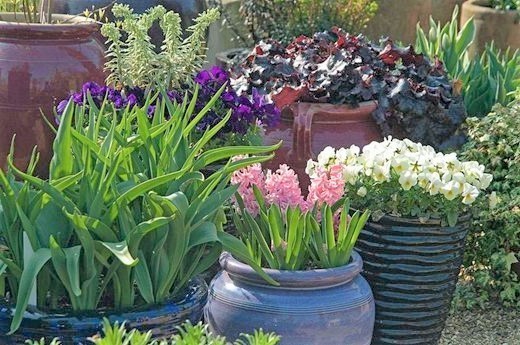Nothing gives a lift to a garden like a well-planted container; better, a group of containers, and at this time of year instant impact and colour is what’s needed. Sadly, a pot is not a plant’s natural habitat, so give the precious darlings a sporting chance by following some simple advice. Firstly, choose wisely. Vigorous
Nothing gives a lift to a garden like a well-planted container; better, a group of containers, and at this time of year instant impact and colour is what’s needed.
Sadly, a pot is not a plant’s natural habitat, so give the precious darlings a sporting chance by following some simple advice.
Firstly, choose wisely. Vigorous fast-growing specimens will often romp away initially, then struggle with lack of space. If you’re a lazy gardener, go for something easily pruned or clipped back; something that isn’t too fussy. Dare I say it, some plants seem to thrive on neglect, like sedums and sempervivums, which have delightful fleshy leaves and come in a range of pretty colours.
In my garden, I’ve grouped them in a large shallow dish which I use as a centrepiece for my garden table.
Read and keep the plant tag; I can’t stress this enough. It will tell you how big your plant will get and how much light, water, and food it will need. Never assume that because you’ve successfully grown, say, clematis before, you can treat every clematis the same way. There are over 200 species, and they differ widely in their requirements. It applies to other plants too.
The tag will also tell you about the plant shape and how it will grow. This is important when considering your container design and how to arrange plant combinations.
Don’t cram your plants into containers that are too small. Without room to grow, they will sulk, and you will spend too much time cajoling them into life with extra watering and feeding. Large containers are easier to look after, and don’t dry out so quickly.
Use good quality, free-draining, multipurpose compost to retain moisture. Later, the nutrients in the compost will be eaten up and it will look pale and crumbly, like a bowl of old cornflakes. Then you must replenish, either by taking off the top layer and adding new, or repotting, possibly in a larger container, if the plant has grown or is struggling.
Regular feeding is important for most plants and adding a slow release fertiliser to the compost can be useful, but most plants tend to die through lack of water.
In summer you might have the chore of watering daily. You’ve watered enough when water seeps out below; not enough, and the plant will probably die!
Janice Cripps is a professional Surbiton garden designer. For advice, planting plans, or projects – from concept to completion – visit www.janicecripps.co.uk










Leave a Comment
Your email address will not be published. Required fields are marked with *